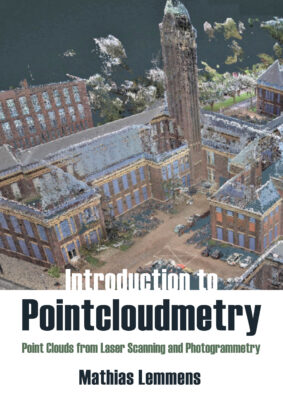 Mathias Lemmens, Geomatics Consultant and Founder of GeoTexs and former Director MSc Geomatics, Delft University of Technology
Mathias Lemmens, Geomatics Consultant and Founder of GeoTexs and former Director MSc Geomatics, Delft University of Technology
- The first in-depth textbook treating the major concepts of point clouds generated by laser scanning as well as overlapping photogrammetric images presented clearly and accessibly aided by numerous illustrations to clarify concepts and formulae (or formulas)
- Perfect core material whether for courses or professional use
There is an enormous need to map cities, rivers, coasts, roads, industrial installations and infrastructure in general, and also vulnerable areas in full three dimensions. It has to be done accurately and in detail. The main technologies for detailed 3D mapping are based on imaging devices (photogrammetry) and Lidar sensors (laser scanning). These geodata acquisition technologies routinely acquire point clouds of billions of points and have matured rapidly since the mid-1990s. They have become key geodata sources for 3D city modelling, creation of digital twins and smart cities, and inspection of roads, railways, and natural features. Many GIS analysts extensively use point clouds in the form of digital elevation models.
Pointcloudmetry is the specialized branch of geomatics that encompasses the acquisition and processing of point clouds captured by Lidar devices as well as point clouds derived from photogrammetric images. The technology allows accurate and detailed geo-information about earth-related objects, including the bare earth surface, to be obtained. This book covers the entire chain from the principles of geo-referencing and the basics of electromagnetic energy up to the generation of 2.5D and 3D geoinformation.
The book provides vital knowledge about the fundamentals, idiosyncrasies and unparalleled potential of point cloud technology and is an indispensable aid to acquiring competent knowledge on the processing steps necessary for converting raw data into high quality 3D geo-information.
Contents: Setting light on the landscape; Electromagnetic energy; Laser light; Photogrammetry and 3D computer vision; Airborne Lidar; Ground-based Lidar; Survey peculiarities; Digital elevation models; Interpolation; Ground filtering; Feature detection from images and point clouds; Point cloud processing software; Pilot studies and applications
Readership: This book will be essential for everyone working in the sphere of geomatics, geography, GIS and the application of this science. The diverse applications of point clouds reflect the relevance to engineers and scientists in a large array of disciplines, such as civil engineering, planning, architecture, oceanography, forestry, geography, surveying, software engineering and many more. Information provided in this book will also be of much use to others who deal with this topic in their daily work, but have no background in geoinformation technology.
ISBN 978-184995-479-2 240 x 170mm c.352pp c.200 illustrations (photos, charts and diagrams) full colour throughout hardback £95 November, 2022
About the author: Mathias Lemmens has been involved in geomatics since 1974 and since 1984 has taught geodata acquisition technologies and geodata quality at Delft University of Technology, where he was also MSc Geomatics Programme Director. As a consultant, he conducted projects in many countries including Estonia, Nigeria and Kenya. He was editor of GIM International until December 2000 and is author of over 500 publications in the fields of photogrammetry, remote sensing, computer vision and Lidar. His popular textbook Geoinformation – Technologies, Applications and The Environment, offers a unique and in-depth overview of geomatics. In 2019 he published the textbook Points on the Landscape – Twenty Years of Geomatics Developments in a Globalizing Society.
